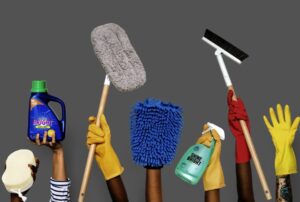Some things are better together—coffee and cream, soap and water. But cleaning products? Not always. In fact, mixing the wrong household cleaners can create toxic gases or corrosive compounds that are hazardous to your health.
Even well-meaning attempts to “deep clean” or “double up” can turn dangerous without proper knowledge of the chemistry involved. Before you start spraying and scrubbing, read this guide to learn what not to mix—and what you can safely use instead.
⚠️ Bleach + Ammonia = Toxic Chloramine Gas
This is one of the most dangerous combinations in home cleaning—and also one of the most common mistakes.
Mixing bleach and ammonia releases chloramine gas, a highly toxic vapor that can cause:
- Coughing and chest pain
- Shortness of breath
- Eye, nose, and throat irritation
- In high concentrations: fluid in the lungs or even death
You’ll find ammonia in many glass cleaners (like Windex), so never mix or follow up with bleach-based products unless you’ve rinsed the surface thoroughly and let it air out completely.
⚠️ Vinegar + Bleach = Chlorine Gas
Both vinegar and bleach are strong cleaners on their own—but never together.
The acidic nature of vinegar causes bleach to release chlorine gas, a potent respiratory irritant that was literally used as a chemical weapon in World War I.
Effects include:
- Burning eyes and throat
- Difficulty breathing
- Lightheadedness or dizziness
- Long-term lung damage in high exposures
If you need to sanitize a surface, use one or the other—never both. And always rinse thoroughly if switching between products.
⚠️ Hydrogen Peroxide + Vinegar = Peracetic Acid (Corrosive)
Separately, both hydrogen peroxide and vinegar are praised as natural disinfectants. But when combined—especially in the same container—they form peracetic acid, a corrosive compound that can irritate the skin, eyes, and respiratory system.
- Never mix them in a bottle or use together in a closed space
- Peracetic acid can damage surfaces over time
- It’s also corrosive to the lining of your lungs if inhaled
If you want to use both on a surface, apply one, rinse, and wait before using the other.
🧴 Common Cleaners That Contain Bleach
These products typically contain sodium hypochlorite (bleach) and are marketed for their disinfecting, whitening, and stain-removal properties. Always check the label.
✅ Popular Brands & Products with Bleach:
- Clorox Disinfecting Bleach
- Clorox Clean-Up Cleaner + Bleach
- Lysol Bleach Multi-Purpose Cleaner
- Tilex Mold & Mildew Remover
- Comet with Bleach
- Soft Scrub with Bleach Cleanser
- Kaboom Mold & Mildew Stain Remover with Bleach
- Scrubbing Bubbles Bathroom Cleaner with Bleach
- Clorox Toilet Bowl Cleaner with Bleach
- Clorox Splash-Less Bleach
- Great Value (Walmart brand) Bleach Cleaners
- Store-brand disinfecting wipes that list bleach or hypochlorite
🧪 Common Cleaners That Contain Ammonia
Ammonia (typically ammonium hydroxide) is a powerful grease cutter and glass cleaner but becomes toxic when mixed with bleach.
✅ Popular Brands & Products with Ammonia:
- Windex Original Glass Cleaner (blue formula)
Note: Not all Windex formulas contain ammonia—look for “with Ammonia-D” on the label. - Glass Plus (some versions)
- Parsons’ Ammonia
- Mr. Clean Multi-Surface Cleaner (some versions)
- Lysol Antibacterial Kitchen Cleaner (some older formulas)
- Greased Lightning Multi-Purpose Cleaner
- Zep Ammonia Glass Cleaner
- Store-brand glass or window cleaners with ammonia (Target, Walmart, etc.)
- Brillo Ammonia All-Purpose Cleaner
✅ Better Combinations (That Are Safe AND Effective)
You don’t have to go full DIY chemist to clean effectively—just stick to combinations that are proven safe:
- Baking soda + vinegar: Useful for drain flushing (though mostly a fizzy reaction, not a disinfectant)
- Castile soap + essential oils: Great for all-purpose spray cleaners
- Dish soap + hydrogen peroxide: Effective for stain removal (especially on laundry or grout)
- Rubbing alcohol + water: A safe disinfecting spray for high-touch surfaces
Always label homemade cleaners clearly and never reuse bottles that previously held other chemicals.
🧼 Tips to Safely Layer Products Over Time (If Needed)
Sometimes you may need to use different products in the same area—like switching from soap to disinfectant. Here’s how to do it safely:
- Rinse thoroughly between products with clean water
- Let surfaces dry fully before applying a new cleaner
- Allow proper air circulation (open windows or run a fan)
- Wear gloves and avoid mixing products on sponges or cloths
- When in doubt, read the label—most cleaners explicitly state what not to mix
✅ Wrap-Up
Cleaning your home shouldn’t come with a chemistry lesson—or a health emergency. Stick to one cleaner at a time, read product labels carefully, and avoid the urge to “amp things up” by mixing products that weren’t meant to go together. Your lungs, skin, and surfaces will thank you.



